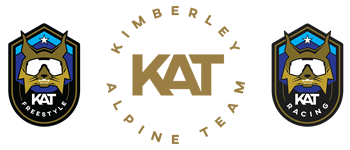EQUIPMENT
Alpine skiing is a “gear intensive” sport but does not require you to buy expensive gear all the time. The following should help you in deciding what equipment is important for your youngster for the formative years of their ski development.
For Entry Level U6 - U10, one pair of all-mountain or multi-event junior skis is appropriate. For freestyle skiing, all mountain or mogul/park skis will work well. Entering U12 Alpine, athletes may benefit from having one pair of SL skis and one pair of GS skis. These may be new or used but should come from any of the well-known suppliers out there that are supporting ski racing in Canada. Look for equipment that was designed for junior racing as opposed to recreation gear. All junior racing products have been designed specifically with junior racing speeds and athlete sizes in mind.
All program participants, competitors and forerunners are obliged to wear a helmet. Helmets used shall be specifically designed and manufactured for the respective discipline and shall bear a CE mark and conform to recognized and appropriate standards such as CEEH. Din 1077 or US 2040, ASTM F2040, SNELL S98 or RS98, etc.
Ski Selection
Guidelines for sizing
It is beneficial to go shorter rather than longer when choosing length for the entry-level participants. A shorter ski will facilitate turning, allowing quicker progression of basic skills and definitely increasing the athletes’ enjoyment of skiing. The ski should be between the nose and the top of the forehead for entry-level participants. Longer skis may be appropriate as skill acquisition occurs. Purchasing skis that are too long may impede skill development in the long term.
Ski Boot Selection
General Mechanics
A distinction needs to be made with respect to performance and comfort factors in boot fitting, keeping in mind that there are 2 options in boots for the entry level athlete; rear entry and overlap design.
Overlap design has a cuff that articulates with the lower shell using a hinge at the ankle joint. This design provides performance for the entry-level participant by allowing natural ankle flexion, due to the hinged cuff of the boot.
The overlap design also allows for lateral action of the lower leg, a critical factor in skill development.
Rear entry design is comprised of a single piece of plastic encompassing the foot. This design provides warmth, and is considered to offer a comfortable fit. Rear entry boots are not however recommended for racing.
Boot Flex
For the entry level, a softer boot will be more effective than a stiffer boot, due to strength limitations and skill level.
To determine if a boot is soft enough, you should be able to see the forward boot flexion happening in the upper cuff simultaneously with the lower leg. If the lower leg moves forward and the upper cuff mover very little, then the boot is too stiff.
The boots should not inhibit the natural alignment of the athlete.
Boot Size
Growth of the participants’ feet during the season needs to be considered, but similar to skis, buying boots over-sized is counter-productive for both performance and fit.
Boots that are fitted poorly have the potential to cause bone spurs and possible medical problems in the long term.
Foot Beds
These are important factor for performance but at the entry level, foot beds do not play an important role due to growth and cost factors. This only becomes a concern at the U14 level.
